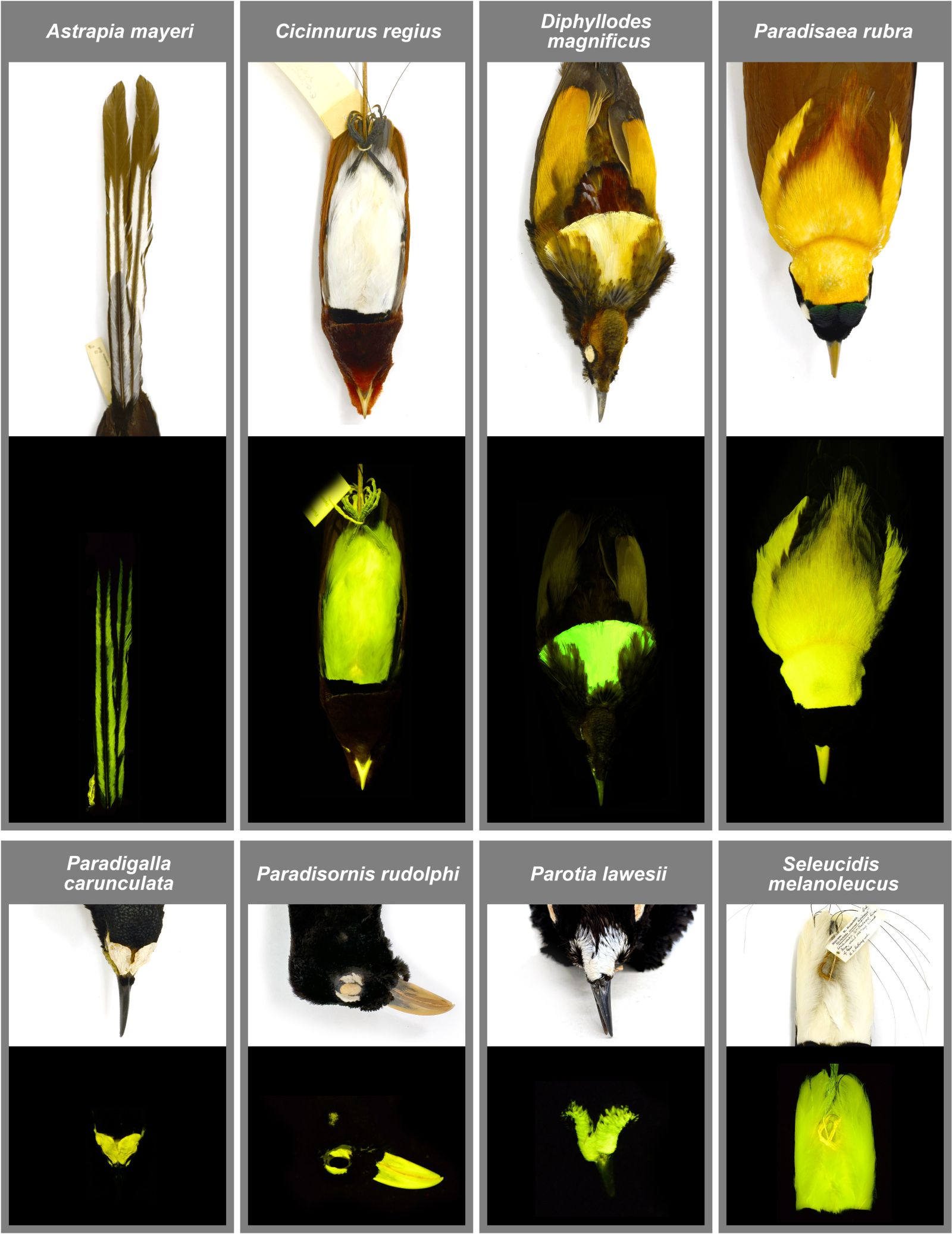Discovery: these birds emit fluorescent light 🦜
Published by Cédric,
Article author: Cédric DEPOND
Source: Royal Society Open Science
Other Languages: FR, DE, ES, PT
Article author: Cédric DEPOND
Source: Royal Society Open Science
Other Languages: FR, DE, ES, PT
Follow us on Google News (click on ☆)
Researchers from the American Museum of Natural History and the University of Nebraska-Lincoln discovered that 37 out of the 45 species of birds of paradise studied exhibit biofluorescence. This phenomenon, observed using specialized photography techniques, is mainly present in males, particularly in areas used during courtship displays. Females, on the other hand, show more discreet fluorescence, limited to certain parts of their plumage.

Examples of eight male bird of paradise species imaged under white light (top) and showing their biofluorescent regions (bottom):
A) Astrapia mayeri (AMNH 705537)
B) Cicinnurus regius (AMNH 303137)
C) Diphyllodes magnificus (AMNH 303088)
D) Paradisaea rubra (AMNH 300993)
E) Paradigalla carunculata (AMNH 678344)
F) Paradisornis rudolphi (AMNH 679027)
G) Parotia lawesii (AMNH 330458)
H) Seleucidis melanoleucus (AMNH 677789)
Biofluorescence, a tool for seduction
Biofluorescence, a phenomenon where an organism absorbs and re-emits light in a different color, is particularly pronounced in male birds of paradise. The fluorescent areas, such as the inside of the beak, legs, and head feathers, are often highlighted during courtship displays. These light signals, invisible to the human eye without specialized equipment, could enhance the males' attractiveness by increasing the contrast with their environment.
Researchers suggest that this fluorescence is perceived by the birds themselves, whose vision is adapted to these wavelengths. In the tropical forests where they live, the light filtered through the canopy could amplify these signals, making the displays even more impressive. The fluorescent patterns, often surrounded by dark feathers, create a visual effect likely to captivate females.
This biofluorescence could also play a role in establishing hierarchies among males. Individuals with the brightest or most complex patterns might be perceived as more dominant or healthier. Thus, fluorescence would not only be a tool for seduction but also a marker of social status in these species.
A still mysterious function in females
In female birds of paradise, biofluorescence is less extensive and mainly concentrated on the chest and belly. Unlike males, who use their fluorescence for spectacular displays, females might exploit this phenomenon for different purposes. Researchers hypothesize that this discreet fluorescence could serve as camouflage, helping to blur the outlines of their silhouette in the forest environment.
Another possibility is that the fluorescent patterns of females could play a role in visual communication. For example, the fluorescent rings around their eyes might signal to males that they are observing them during their displays. This type of discreet signal would allow females to remain visible without attracting the attention of predators, while actively participating in social interactions.
Finally, fluorescence in females could also be an evolutionary vestige, less pronounced than in males due to different selective pressures. While males have developed exaggerated traits to seduce, females, being more discreet, might use their fluorescence in a more subtle way, whether for camouflage or social signals. This duality remains a subject for future research.
To go further: What is biofluorescence?
Biofluorescence is a natural phenomenon where an organism absorbs light at a certain wavelength, often in the ultraviolet (UV) or blue range, and re-emits it at a longer wavelength, usually in the green, yellow, or orange range. Unlike bioluminescence, which produces light through internal chemical reactions (as in fireflies), biofluorescence requires an external light source to "light up." This process is made possible by molecules called fluorophores, present in the tissues or pigments of the organism.
In animals, biofluorescence is often used for communication, camouflage, or even hunting. For example, some coral reef fish emit fluorescent patterns to recognize each other among species or blend into their environment. In birds of paradise, fluorescence seems to play a role in courtship displays, reinforcing the visual signals of these species. This phenomenon is particularly effective in environments where light is filtered, such as under the canopy of tropical forests.
Finally, biofluorescence is a recent and rapidly expanding field of study. While it was initially associated with marine species, such as jellyfish or corals, it is now observed in mammals, reptiles, amphibians, and, of course, birds. This discovery opens new perspectives on how animals perceive and interact with their environment, revealing unsuspected evolutionary strategies.